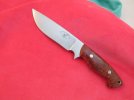- Joined
- Feb 24, 2000
- Messages
- 1,862
Over the years I have tried a lot of different sanding belts and combinations of sanding belts. What I now use may not be for everyone, but I find it works very well for me.
The belts I use are Norton Blaze 980 belts in 36,60,120 grits, Klingspor J-Flex belts in 220 and 400 grit, and Norax 22.
I will describe how I do a stock removal blade, but when I forge, I use the same progression.
1. To profile the outline of the blade I use a dull 36 grit belt. Some use a bandsaw for this, but I find I can quickly get the job done with a dull 36 grit belt that isn't good for anything else. These belts last a long, long time.
2. To taper the tang I use a new 36 grit belt and use the method in Bob Loveless' book "How to make knives." It's easy and fast.
3. To make the bevels I use a worn 36 grit belt on a 14" wheel. These belts last a long, long time before I use the belt to profile the outline.
4. Next I use a 60 grit belt on a 10" wheel to get the 36grit scratches out. The 60 grit belt lasts a long time and takes just a few minutes to get the 36 grit scratches out.
5. Next I use a 120 grit belt to get the 60 grit scratches out. If I am using CPM 154, I first use the 120 grit belt to do the flats on the blade. When the 120 grit belt starts to get dull, I use it to get the 60 grit scratches out. These belts last a long, long time, and quickly get the 60 grit scratches out.
6. Next I use a 220 J-flex belt to clean up the plunge cuts and get the 120 grit scratches out. These belts do not last very long. Maybe 5 blades, but they are flexible and are good to clean up the plunge cuts. It takes a very few minutes.
7. The I use a 400 J-flex belt the same way. These belts do not last very long, maybe 5 blades, but again they are flexible and do a nice job of cleaning up the plunge cuts. Again, it takes a very few minutes.
8. Last I use a 22 Norax belt. These belts seem to last forever. They get all the scratches out and makes hand sanding very quick.
9. Next I hand sand with 400,500,600,800,1200 grit sandpaper. If I have done a proper job with the sanding belts, the hand sanding doesn't take long.
I would invite others to tell of your sanding belt progression. I am including a picture of the final product and would also invite others to show a picture of the results of their sanding progression.
The belts I use are Norton Blaze 980 belts in 36,60,120 grits, Klingspor J-Flex belts in 220 and 400 grit, and Norax 22.
I will describe how I do a stock removal blade, but when I forge, I use the same progression.
1. To profile the outline of the blade I use a dull 36 grit belt. Some use a bandsaw for this, but I find I can quickly get the job done with a dull 36 grit belt that isn't good for anything else. These belts last a long, long time.
2. To taper the tang I use a new 36 grit belt and use the method in Bob Loveless' book "How to make knives." It's easy and fast.
3. To make the bevels I use a worn 36 grit belt on a 14" wheel. These belts last a long, long time before I use the belt to profile the outline.
4. Next I use a 60 grit belt on a 10" wheel to get the 36grit scratches out. The 60 grit belt lasts a long time and takes just a few minutes to get the 36 grit scratches out.
5. Next I use a 120 grit belt to get the 60 grit scratches out. If I am using CPM 154, I first use the 120 grit belt to do the flats on the blade. When the 120 grit belt starts to get dull, I use it to get the 60 grit scratches out. These belts last a long, long time, and quickly get the 60 grit scratches out.
6. Next I use a 220 J-flex belt to clean up the plunge cuts and get the 120 grit scratches out. These belts do not last very long. Maybe 5 blades, but they are flexible and are good to clean up the plunge cuts. It takes a very few minutes.
7. The I use a 400 J-flex belt the same way. These belts do not last very long, maybe 5 blades, but again they are flexible and do a nice job of cleaning up the plunge cuts. Again, it takes a very few minutes.
8. Last I use a 22 Norax belt. These belts seem to last forever. They get all the scratches out and makes hand sanding very quick.
9. Next I hand sand with 400,500,600,800,1200 grit sandpaper. If I have done a proper job with the sanding belts, the hand sanding doesn't take long.
I would invite others to tell of your sanding belt progression. I am including a picture of the final product and would also invite others to show a picture of the results of their sanding progression.

